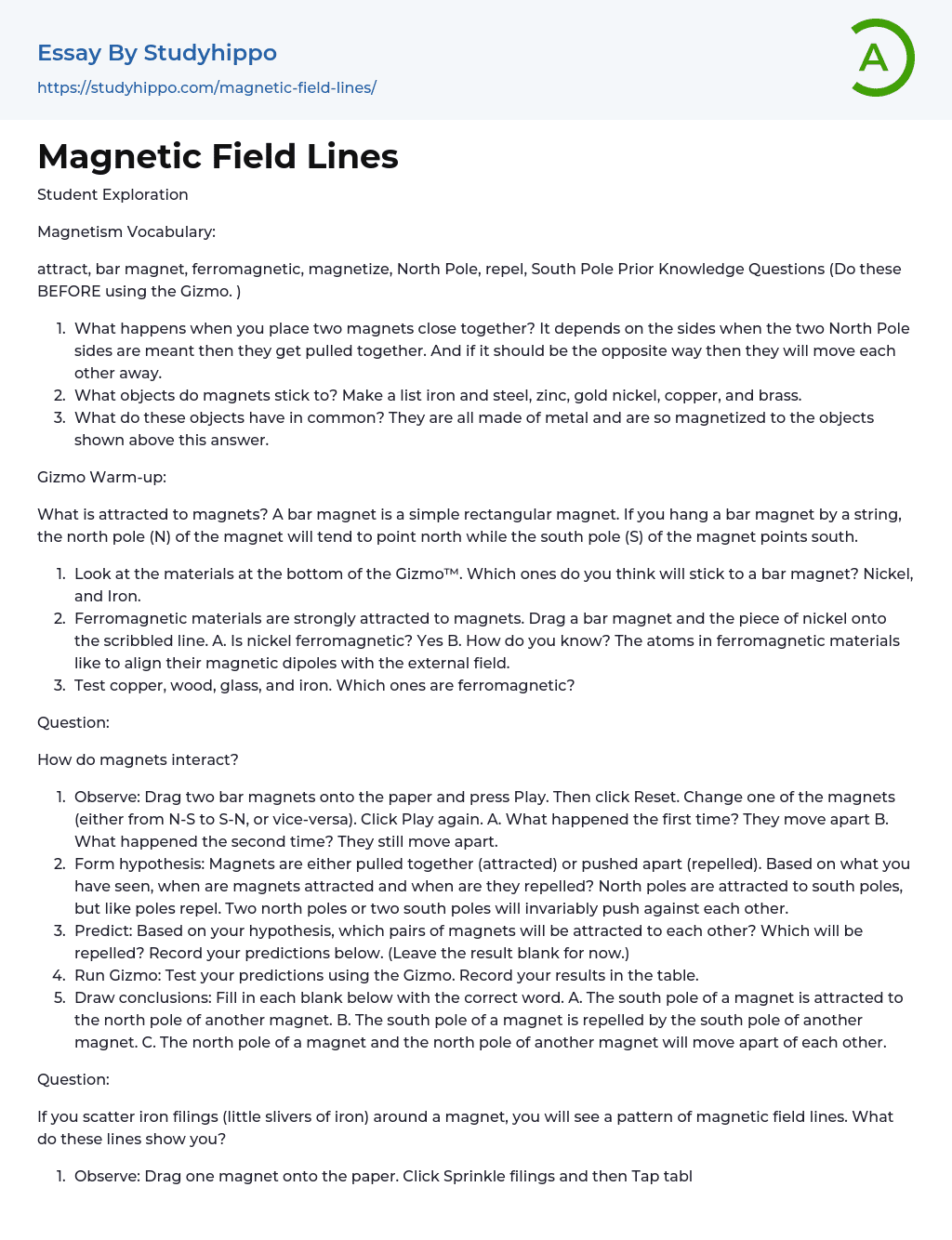Student Exploration
Magnetism Vocabulary:
attract, bar magnet, ferromagnetic, magnetize, North Pole, repel, South Pole Prior Knowledge Questions (Do these BEFORE using the Gizmo. )
- What happens when you place two magnets close together? It depends on the sides when the two North Pole sides are meant then they get pulled together. And if it should be the opposite way then they will move each other away.
- What objects do magnets stick to? Make a list iron and steel, zinc, gold nickel, copper, and brass.
- What do these objects have in common? They are all made of metal and are so magnetized to the objects shown above this answer.
Gizmo Warm-up:
What is attracted to magnets? A bar magne
...t is a simple rectangular magnet. If you hang a bar magnet by a string, the north pole (N) of the magnet will tend to point north while the south pole (S) of the magnet points south.
- Look at the materials at the bottom of the Gizmo™. Which ones do you think will stick to a bar magnet? Nickel, and Iron.
- Ferromagnetic materials are strongly attracted to magnets. Drag a bar magnet and the piece of nickel onto the scribbled line. A. Is nickel ferromagnetic? Yes B. How do you know? The atoms in ferromagnetic materials like to align their magnetic dipoles with the external field.
- Test copper, wood, glass, and iron. Which ones are ferromagnetic?
Question:
How do magnets interact?
- Observe: Drag two bar magnets onto the paper and press Play. Then click Reset. Change one of th
magnets (either from N-S to S-N, or vice-versa). Click Play again. A. What happened the first time? They move apart B. What happened the second time? They still move apart.
Question:
If you scatter iron filings (little slivers of iron) around a magnet, you will see a pattern of magnetic field lines. What do these lines show you?
- Observe: Drag one magnet onto the paper. Click Sprinkle filings and then Tap table five or six times. Sketch the pattern you see in the box: What do you notice about the iron filings? They make lines that connect the North Pole and the south pole of the
magnet.
Question:
Why do magnets attract certain materials?
- Observe: Click Sprinkle filings and then click Tap table several times. Look closely at the filings near the copper bar. Does copper have any effect on the filings? _No there won’t be any magnet field because copper isn’t ferromagnetic.
- Observe: Repeat the experiment with iron. What effect does iron have on the filings? Iron bends the filings around it like a
magnet would. Magnetic field lines also connect the iron bar to the magnet. 3 The Iron does have a small magnetic field contains a ferromagnetic force.
- Organic Chemistry essays
- Acid essays
- Calcium essays
- Chemical Bond essays
- Chemical Reaction essays
- Chromatography essays
- Ethanol essays
- Hydrogen essays
- Periodic Table essays
- Titration essays
- Chemical reactions essays
- Osmosis essays
- Carbohydrate essays
- Carbon essays
- Ph essays
- Diffusion essays
- Copper essays
- Salt essays
- Concentration essays
- Sodium essays
- Distillation essays
- Amylase essays
- Magnesium essays
- Acid Rain essays
- Agriculture essays
- Albert einstein essays
- Animals essays
- Archaeology essays
- Bear essays
- Biology essays
- Birds essays
- Butterfly essays
- Cat essays
- Charles Darwin essays
- Chemistry essays
- Dinosaur essays
- Discovery essays
- Dolphin essays
- Elephant essays
- Eli Whitney essays
- Environmental Science essays
- Evolution essays
- Fish essays
- Genetics essays
- Horse essays
- Human Evolution essays
- Isaac Newton essays
- Journal essays
- Linguistics essays
- Lion essays




